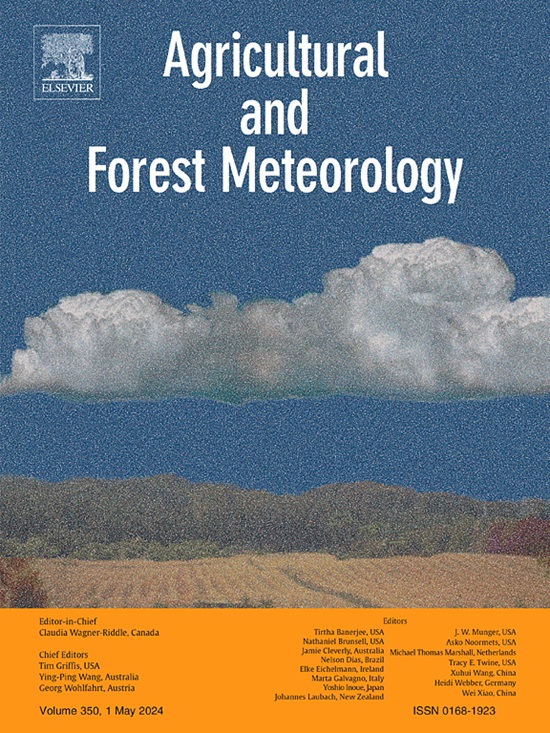压力引发全球森林树木生长反弹
IF 5.6
1区 农林科学
Q1 AGRONOMY
引用次数: 0
摘要
植物通过各种生态过程维持自身健康,其中对外部胁迫的恢复能力近年来越来越受到关注。通过分析来自 1762 个地点的树环数据(共包括 1,623,006 个弱胁迫(mean-2sd ≤ tree ring indices (TRI) <;mean-sd)和 320,345 个强胁迫(TRI <;mean-2sd)),我们观察到一部分树木在胁迫后生长显著增加。我们发现,生长增加并不是胁迫后气候的结果,而是树木对胁迫反应的固有特性,可称为 "反弹效应"。在研究的所有 16 个属中,有类似比例的树木(分别为 26.23% 和 25.73%)在弱胁迫和强胁迫后的第一年表现出反弹效应。在弱胁迫和强胁迫后,生长反弹的幅度分别为 0.242 和 0.266,即反弹年份的环宽指数平均值与随后八年的环宽指数平均值之差。与阔叶树相比,针叶树的反弹比例一般较高,但幅度较小。此外,树龄较长、生长较慢的树木的反弹比例更高,反弹幅度更大。我们的研究结果为树木的抗干扰能力提供了一个新的视角,并揭示了生长受抑制后森林恢复的过程。本文章由计算机程序翻译,如有差异,请以英文原文为准。
Stress triggers tree-growth rebound in global forests
Plants maintain their health through various ecological processes, among which resilience to external stresses has received increasing attention in recent years. By analyzing tree-ring data from 1762 sites, encompassing a total of 1,623,006 weak stresses (mean-2sd ≤ tree ring indices (TRI) < mean-sd) and 320,345 strong stresses (TRI < mean-2sd), we observed a significant growth increase following stresses for a subset of trees. We found that the growth increase was not a consequence of post-stress climate but an inherent property of trees’ response to stresses that could be called “rebound effect”. Across all the 16 genera studied, a similar proportion of trees, 26.23 % and 25.73 %, exhibits rebound effect in the first year after weak and strong stresses, respectively. The amplitudes of growth rebound, measured as the difference between the mean of ring-width indices in the rebounding year and the subsequent eight years, are 0.242 and 0.266 after weak and strong stresses, respectively. Conifers generally rebound at a higher proportion but to a lesser amplitude than broadleaves. Furthermore, a higher proportion and greater amplitude of rebound were observed in trees having longer age and slower growth. Our findings provide a new perspective of tree resilience to disturbances and shed insights into the processes of forest recovery after growth suppressions.
求助全文
通过发布文献求助,成功后即可免费获取论文全文。
去求助
来源期刊
CiteScore
10.30
自引率
9.70%
发文量
415
审稿时长
69 days
期刊介绍:
Agricultural and Forest Meteorology is an international journal for the publication of original articles and reviews on the inter-relationship between meteorology, agriculture, forestry, and natural ecosystems. Emphasis is on basic and applied scientific research relevant to practical problems in the field of plant and soil sciences, ecology and biogeochemistry as affected by weather as well as climate variability and change. Theoretical models should be tested against experimental data. Articles must appeal to an international audience. Special issues devoted to single topics are also published.
Typical topics include canopy micrometeorology (e.g. canopy radiation transfer, turbulence near the ground, evapotranspiration, energy balance, fluxes of trace gases), micrometeorological instrumentation (e.g., sensors for trace gases, flux measurement instruments, radiation measurement techniques), aerobiology (e.g. the dispersion of pollen, spores, insects and pesticides), biometeorology (e.g. the effect of weather and climate on plant distribution, crop yield, water-use efficiency, and plant phenology), forest-fire/weather interactions, and feedbacks from vegetation to weather and the climate system.

 求助内容:
求助内容: 应助结果提醒方式:
应助结果提醒方式:


